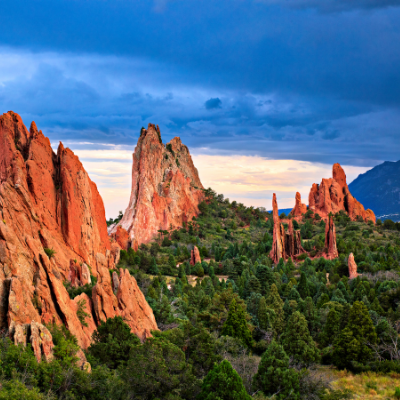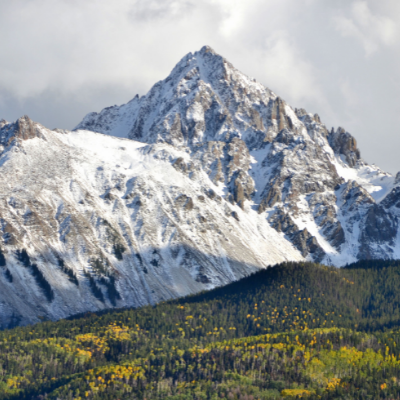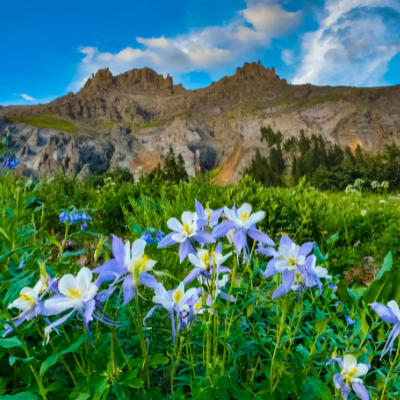Moving to Colorado: Discover the Glorious Centennial State
We created this guide for moving to Colorado to help those who are in their early stages of researching where they’d like to move. So, what exactly do you need to know before moving to Colorado? We’ve compiled some of the most important items you should consider when making this big decision.
According to 2020 Census data, Colorado was one of the top ten fastest growing states of the last decade in terms of population, with a massive 14.8% growth in population. So, is moving to Colorado right for you?
What You Need to Know about Colorado’s Geography

Colorado is in the Mountain West subregion of the Western U.S., with Wyoming to the north, Nebraska to the northeast, Kansas to the east, Oklahoma to the southeast, New Mexico to the south, Utah to the west, and touches of Arizona to the southwest at the Four Corners region.
Fun fact: Colorado is one of only three states that have their borders defined solely by straight boundary lines with no natural features! That’s definitely something you can brag about after moving to Colorado! If you love exploring the outdoors, Colorado may be the right place for you. In fact, with an area of 104,094 square miles, Colorado has several distinct geographic and climate regions within its borders.
East of the Rocky Mountains are the Colorado Eastern Plains of the High Plains, which are mostly prairies, but also include deciduous forests, buttes, and canyons. This part of Colorado is mainly farmland and rangeland.
The central region of the state is home to roughly 70% of Colorado’s population and the Rocky Mountains! This is also where you’ll find the Continental Divide. West of the Rocky Mountains, and in the western part of the state, you’ll find the Western Slope area which includes terrains and climates from alpine mountains to arid deserts. In south central Colorado, you’ll find the San Luis Valley, where the headwaters of the Rio Grande are located.
From the Dinosaur National Monument, which not only is a paleontological area, but also a scenic area of rocky hills, canyons, arid deserts, and streambeds in the northwest to the famous Pikes Peak just west of Colorado Springs, and the White River National Forest and the Grand Mesa in between, Colorado has a lot of incredible nature to behold. (There are also lots of interesting museums around the state, including the Denver Art Museum, the Denver Zoo, and the Anasazi Heritage Center, to name a few!)
Colorado’s highest point, Mount Elbert, stands at 14,440 ft tall. By comparison, Colorado’s lowest point found in the Arikaree River, and it’s only 3,317 ft, which is still higher than the highest elevation points of eighteen states and the District of Columbia! Colorado is the only state that lies entirely above 1,000 meters elevation, and there is certainly a lot to “look up to” here!
Moving to Colorado Guide on the Weather in Colorado

Colorado’s climate is more complex than states outside the Mountain States region. In fact, southern Colorado is not always warmer than northern Colorado! The Eastern Plains is semiarid, with low humidity and moderate precipitation. The area is known for abundant sunshine and cool, clear nights with summer daytime highs climbing above ninety-five degrees and winter lows dropping below freezing.
Moving just west of the plains and into the foothills of the Rocky Mountains presents a wide variety of climate types. Most valleys are also semi-arid, but this transitions into an alpine climate at higher elevations. In fact, there are microclimates of almost every kind in this part of the state!
This just means monthly normal high and low temperatures really depend on where in the state you live. Winters in parts of the state can see super low temperatures below zero and lots of snow. Spring brings major transition in Colorado with some snowstorms still possible and temperatures usually much hotter after the harsh winter.
This is when Colorado sometimes sees tornado outbreaks, but the risk diminishes slowly through the summer and into the fall. The Plains region is susceptible to flooding, and much of the state is very dry and frequently experiencing some degree of a drought.
The state has dangers associated with tornados, wildfires, blizzards, flooding, and extreme hot and cold temperatures, which should be something to consider if you plan to build a home.
Moving to Colorado Guide on Getting a Job in the Centennial State

If you’re looking for a place to grow your career, consider moving to Colorado! According to the state government’s website, at the time of authoring this article, the state of Colorado has seen a steady job growth rate compared to the rest of the United States.
Moreover, the state even has a Job Growth Incentive Tax Credit, an eight-year job creation incentive that provides a state income tax credit equal to 50% of the Federal Insurance Contributions Act to support competitive, multi-state or country relocation and expansion projects.
Colorado continues to add more jobs, resulting in a steady state-wide unemployment rate of around 6.1%. Industries showing solid job gains included natural resources and mining, information, and professional and business services.
Alcohol Laws to Know Before Moving to Colorado

Who isn’t curious about how to toast moving to a new state! In Colorado, a person must be twenty-one to buy or consume alcohol and it is illegal to drive with a blood alcohol level over 0.08%. Interestingly, previously opened bottles of alcohol must be stored in a car’s trunk as there can be no open containers in the passenger area.
Fun fact: Colorado used to be famous for its “3.2” laws, meaning venders with alcohol licenses could only sell 3.2% alcohol beer from 5:00 a.m. until midnight 365 days a year. This law was recently removed, but it’s still neat to know!
What is there to do in Colorado?

Hopefully you like being outside! Colorado is home to four national parks: Rocky Mountain, Mesa Verde, Great Sand Dunes, and Black Canyon of the Gunnison. Each of the four parks has some of the world’s most wondrous and diverse scenery.
Colorado is also home to eight national monuments and three national historic areas meaning you’ll always have something new to see in the greatness that is natural Colorado. Another choice for entertainment is to head over to the state capital of Denver or even neighboring Boulder for culture, food, and fun.
Both are big cities, and they boast a variety of fun and interesting things to do including the Molly Brown House in Denver and the Boulder International Film Festival in Boulder. Both cities also boast incredible food culture and exciting nightlife. However, if you’re like us, we’re sure you’ll agree that outdoor Colorado is the best. You’ll be in awe each and everything you step outside!
Important State Symbols in Colorado

The state of Colorado has almost thirty official state symbols; we’ve included a few of our favorites here. The first, and most important, is the state’s name. What is now Colorado was inhabited for thousands of years by various Native American tribes, with the Lindenmeier Site containing artifacts dating from approximately 9200 BCE to 1000 BCE. “Colorado” comes from the Spanish adjective meaning “ruddy,” the color of sandstone.
Colorado’s nickname, the Centennial State, came to be because Colorado became a state one century after the signing of the Declaration of Independence! Before moving to Colorado, you should definitely know the state animal is the Rocky Mountain Bighorn Sheep, and the flower is the Rocky Mountain Columbine. Another one of our favorite Colorado symbols is the state pet: rescue dogs & cats. Probably the most unexpected state symbol is the state tartan – Colorado District Tartan!
Lesser-Known FAQs About Moving to Colorado
Q: What is the capital of Colorado?
A: The capital of Colorado is Denver. Denver is also the most populated city in Colorado. Since the 2010 census, Denver saw a 19.22% increase in population and is continuing to grow! Denver is in the South Platte River Valley just east of the Front Range of the Rocky Mountains. It got its name from James W. Denver, a governor of the Kansas Territory, and its nickname, the Mile High City, because its official elevation is exactly one mile above sea level. If you plan to move to Colorado, you’ll probably find yourself here!
Q: How do Colorado’s public schools rank nationally?
A: According to a study by US News, Colorado public high schools rank 9/50 in a national breakdown tracking state-by-state high school performance. While education quality can vary widely depending on where in the state you live, this report takes the weighted average of the state’s high school performance into consideration. Being in the top ten across the country is sure a mountainous achievement!
Q: What kind of taxes can you expect to pay in Colorado?
A: Colorado has a flat income tax rate of 4.63%, and one of the lowest statewide sales taxes in the country, at just 2.90%. However, because of numerous additional county and city sales taxes, actual combined rates can be as high as 11.20%.
Most capital gains are taxed at the standard income tax rate of 4.63%%, but there is no estate or inheritance tax in Colorado. The state’s average effective property tax rate is 0.49%. Colorado also has one of the lowest gas taxes in the U.S.
Q: What’s it like to vote in Colorado?
A: To be eligible to vote in Colorado, you must be a U.S. citizen; 18 years old, with a few limited exceptions; a Colorado resident for at least 22 days before an election; and not serving a sentence for a felony conviction. You must have established residency to register to vote.
Once you have established residency, it exists until you establish a new residency. Colorado does have an absentee ballot process which allows registered voters to vote by mail if they so choose.
Q: What are the rules for switching your driver’s license in Colorado?
A: After moving to Colorado, you’ll need to transfer your out-of-state driver’s license for a Colorado license. To do this, you’ll need to bring your out-of-state driver’s license, a certified original state- or country-issued birth certificate, your social security card, and two proof of current physical Colorado address documents to your local Department of Motor Vehicles.
You may also need to complete a written test or an eye test. There will be an applicable fee to pay after you pass the written test!
Q: When do you need to update your car plates in Colorado?
A: Colorado requires that you convert your out-of-state title to a Colorado title before you register your vehicle. You must then provide proof of insurance and emissions to the clerk and recorder before registration can occur. Then, you’ll need to pay the title and registration fees and your Colorado title will be mailed to you. The law requires that this happens within ninety days of becoming a Colorado resident!
Q: What’s it like driving in Colorado?
A: Like most state, the driving conditions in Colorado are very different in urban and rural areas. Colorado ranked at number 21 as the state with the worst drivers in America. Now, that doesn’t mean Colorado drivers are perfect – it just means you can’t just look out the window at the scenic countryside!
Q: Does Colorado have any walkable cities?
A: Of all cities in Colorado, the best bet for having a walkable lifestyle is going to be in Denver, Boulder, or Colorado Springs, but even that’s going to be difficult. All three cities are ranked nationally for their walkability, and have varying degrees of public transportation, but neither is perfectly walkable. Consider getting a bike if you want a break from sitting in the car on those good weather days you’ll enjoy after moving to Colorado!
Is Colorado the Right State for You to Move?

For those of you looking for lots of space, while enjoying living in a place with a rich history, Colorado (and specifically the city of Denver) may be the right fit for you. The beautiful typography of Colorado, low taxes, and growing economy all lend themselves into making life great in the Centennial State. However, natural disasters like blizzards, tornados, and extreme temperatures prove that while exceptional, Colorado isn’t perfect.



